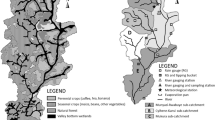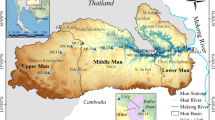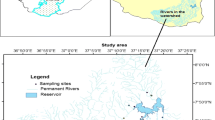Abstract
Agricultural activities release variable products into air, soil and water ecosystems. The study was conducted to evaluate the impact of agriculture and concentrated livestock operations on stream and lake water quality in Grand Lake St. Marys watershed of north-western Ohio. Temporal water samples from the lake and the 6 feeding streams were collected bimonthly from January 2005 to May 2007, processed and measured for temperature, turbidity, pH, electrical conductivity (E C), ammonium \(\left( {{\text{NH}}_{\text{4}}^{\text{ + }} } \right)\), nitrate \(\left( {{\text{NO}}_{\text{3}}^ - } \right)\), dissolved phosphorus (P), ultra-violet (UV) light absorption, and dissolved oxygen (DO), employing standard methods of analysis. The measured data were normalized and integrated into a simple index (WQIndex) to evaluate overall water quality. Results showed that over 90% of the area in the watershed was under cropland with associated livestock operations. With a land area equal to 195 km2 represented by the six major tributaries, the average animal density was over 240 units km−2. As a result, land disposal of manure from confined feedings operations and direct deposit by grazing animals contributed to non-point sources of water pollution. While \(\left( {{\text{NH}}_{\text{4}}^{\text{ + }} } \right)\) and P concentration, turbidity, and UV absorption peaked during the summer, the \(\left( {{\text{NO}}_{\text{3}}^ - } \right)\) and DO concentration in both stream and lake water was lowest in the summer. Water sampled from the Coldwater, Beaver and Prairie creeks had higher turbidity, \(\left( {{\text{NH}}_{\text{4}}^{\text{ + }} } \right)\), and P than other creeks. However, DO concentration and UV absorption of water did not change significantly by the influence of streams. The WQIndex peaked in both streams and lake water with greater water quality degradation in Beaver and Coldwater creek than other creeks. A significant relationship of WQIndex with UV absorption and P accounted 84 to 90% of the variations in stream and lake water quality degradation. However, a strong linear relationship (r 2 = 0.81; p<0.01) between UV absorption and P concentration suggested a major contribution of P to the degradation of stream and lake water quality through algal blooming and associated eutrophication.




Similar content being viewed by others
References
Barkle, G. F., Brown, T. N., & Painter, D. J. (1999). Leaching of particulate organic carbon from land-applied dairy farm effluent. Soil Science, 164, 252–263.
Berg, R. D., & Carter, D. L. (1980). Furrow erosion and sediment losses on irrigated cropland. Journal of Soil and Water Conservation, 35, 267–270.
Bicudo, J. R., & Goyal, S. M. (2003). Pathogens and manure management systems: A review. Environment & Technology, 24, 115–130.
Burnison, B. K., Hartmann, A., Lister, A., Servos, M. R., Ternes, T., & Van Der Kraak, G. (2003). A toxicity identification evaluation approach to studying estrogenic substances in hog manure and agricultural runoff. Environmental Toxicology and Chemistry, 22, 2243–2250.
Carpenter, S. R., Caraco, N. F., Correll, D. L., Howarth, R. W., Sharpley, A. N., & Smith, V. H. (1998). Nonpoint pollution of surface waters with phosphorus and nitrogen. Ecological Applications, 8, 559–568.
Chichester, F. W. (1977). Effects of increased fertilizer rates on nitrogen content of runoff and percolate from monolith lysimeters. Journal of Environmental Quality, 6, 211–217.
Clesceri, L. S., Greenberg, A. E., & Eaton, A. D. (1998). Standard methods for the examination of water and wastewater (20th ed.). Washington, DC: American Public Health Association.
Cook, M. J., & Baker, J. L. (2001). Bacteria and nutrient transport to tile lines shortly after application of large volumes of liquid swine manure. Transactions of the American Society of Agricultural Engineers, 44, 495–503.
David, M. B., & Gentry, L. E. (2000). Anthropogenic inputs of nitrogen and phosphorus and riverine export for Illinois, USA. Journal of Environmental Quality, 29, 494–508.
Dean, D. M., & Foran, M. E. (1992). The effect of farm liquid waste application on tile drainage. Journal of Soil and Water Conservation, 47, 368–369.
Dillon, P. J., & Kirchner, W. B. (1975). The effects of geology and land use on the export of phosphorus from watersheds. Water Research, 9, 135–148.
Foster, P., & Morris, A. W. (1971). The use of ultra-violet absorption measurements for the estimation of organic pollution in inshore sea waters. Water Research, 5, 19.
Geohring, L. D., McHugh, O. V., Walter, M. T., Steenhuis, T. S., Akhtar, M. S., & Walter, M. F. (2001). Phosphorus transport into subsurface drains by macropores after manure applications: Implications for best manure management practices. Soil Science, 166, 896–909.
Gilliam, F.S., May, J. D., Fisher, M.A., & Evans, D. K. (1999). Shortterm changes in soil nutrients during wetland creation. Wetlands Ecology and Management, 6, 203–208.
Goolsby, D. A., Battaglin, W. A., Lawrence, R. S. Artz, B. T., Aulenbach, R. P., Hooper, D. R., et al. (1999). Flux and sources of nutrients in the Mississippi–Atchafalaya River Basin. Topic 3. Report of the Integrated Assessment on Hypoxia in the Gulf of Mexico. NOAA Coastal Ocean Program Decision Analysis Series No. 17. NOAA Coastal Ocean Program, Silver Spring, MD.
Hoorman, J. J. (2004a). Ohio liquid manure violation water quality data. Ohio Journal of Science, 104, A–34.
Hoorman, J. J. (2004b). Manure violations: summary of manure spill and fish kill reports. In: Liquid animal manure application on drained cropland conference, Columbus, Ohio.
Hoorman, J. J., Prochaska, S. C., Rausch, J. N., & Fritz, M. (2005a). Ohio swine farm manure application survey. Ohio Journal of Science, 104, A–34.
Hoorman, J. J., Prochaska, S. C., Rausch, J. N., & Fritz, M. (2005b). Ohio dairy farm manure application survey. Ohio Journal of Science, 104, A–34.
Hoorman, J. J., & Shipitalo, M. J. (2006). Factors contributing to the movement of liquid animal wastes to subsurface drains. Journal of Soil and Water Conservation, 61, 94A–97A.
Jamieson, R. C., Gordon, R. J., Sharples, K. E., Stratton, G. W., & Madani, A. (2002). Movement and persistence of fecal bacteria in agricultural soils and subsurface drainage water: A review. Canadian Biosystems Engineering, 44, 1.1–1.9.
Joy, D. M., Lee, H., Reaume, C. M., Whiteley, H. R., & Zelin, S. (1998). Microbial contamination of subsurface tile drainage water from field applications of liquid manure. Canadian Agricultural Engineering, 40, 153–160.
Kay, P., Blackwell, P. A., & Boxall, A. B. A. (2004). Fate of veterinary antibiotics in a macroporous tile drained clay soil. Environmental Toxicology and Chemistry, 23, 1136–1144.
Keeney, D. R., & DeLuca, T. H. (1993). Des Moines River nitrate in relation to watershed agricultural practices: 1945 versus 1980’s. Journal of Environmental Quality, 22, 267–272.
Kroening, S. E., & Fallon, J. D. (1996). Sources and sinks for nitrogen and phosphorus in part of the Upper Mississippi River Basin, Minnesota and Wisconsin, 1991–93 [Abstract]. In: Minnesota Water ‘96—Changing patterns of power and responsibility: Implications for water policy, Fifth Biennial Conference on Water Resources in Minnesota, University of Minnesota, Water Resources Research Center, May 20–21, 1996, p. 96.
Ogura, N., & Hanya, T. (1968a). Ultra-violet absorption of the sea-water in relation to organic and inorganic matters. International Journal of Oceanology and Limnology, 1, 19.
Ogura, N., & Hanya, T. (1968b). Ultra-violet absorption as an index of pollution of seawater. Journal—Water Pollution Control Federation, 40, 464.
OEC (Ohio Environmental Council). (2003). Dead in the water: A comprehensive analysis of fish kills in Ohio. Retrieved from http://www.theoc.org/pdfs/ditw.pdf.
OEPA. (2004). Integrated water quality monitoring and water quality report. Retrieved from http://www.epa.state.oh.us/dsw/tmdl/2004IntReport/final_2004IR_main_text.pdf.
OEPA. (2007). TMDL development for the Beaver Creek and Grand Lake St. Mary’s Watershed, Ohio. Retrieved from http://www.epa.state.oh.us/dsw/tmdl/BeaverGLSM_TMDL_draft_FS_jun07.pdf.
Power, J. F., Flowerday, A. D., Wiess, R. A., & Watts, D. G. (1998). Agricultural nitrogen management to protect water quality. IDEA no. 4, pp 2–4. USDA.
SAS Institute (2001). SAS Users’ Guide. R 8.2; SAS Institute, Cary, NC.
Schindler, D. W. (1977). Evolution of phosphorus limitation in lakes. Science, 195, 260–262.
Stamm, C., Sermet, R., Leuenberger, J., Wunderli, H., Wydler, H., Flühler, H., et al. (2002). Multiple tracing of fast solute transport in a drained grassland soil. Geoderma, 109, 245–268.
Tsegaye, T., Sheppard, D., Islam, K. R., Johnson, A., Tadesse, W., Atalay, A., et al. (2006). Development of chemical index as a measure of in-stream water quality in response to land use practices. Water, Air and Soil Pollution, 174, 161–179.
USDA-SCS (1975). Soil survey of Mercer County, pp 40–49.
USGS-NAWQA. (2000). Nutrients in the nation’s water: The major influences on nutrient concentrations in water. Cir. 1136.
Author information
Authors and Affiliations
Corresponding author
Rights and permissions
About this article
Cite this article
Hoorman, J., Hone, T., Sudman, T. et al. Agricultural Impacts on Lake and Stream Water Quality in Grand Lake St. Marys, Western Ohio. Water Air Soil Pollut 193, 309–322 (2008). https://doi.org/10.1007/s11270-008-9692-1
Received:
Accepted:
Published:
Issue Date:
DOI: https://doi.org/10.1007/s11270-008-9692-1




